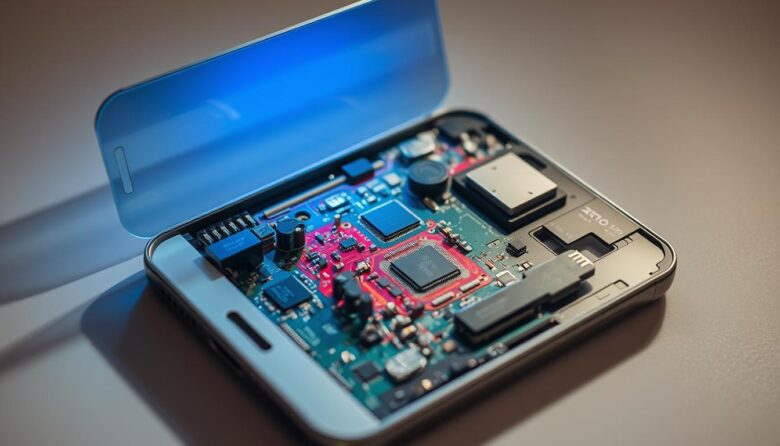Smartphones contain powerful tools most users never discover. Special number combinations unlock diagnostic menus and system data not visible in standard settings. These sequences work across most modern devices, offering direct access to hardware tests and software insights.
Technicians often use these numeric shortcuts to identify network issues or check component health. By entering specific patterns in the dialer app, users bypass complicated menus. Two core protocols power this functionality: USSD and MMI. Both translate codes into actionable commands for the device.
Many hidden tools serve practical purposes. For example, one sequence reveals detailed battery statistics, while another tests touchscreen responsiveness. Manufacturer-specific variations exist, but most core functions remain consistent across brands. This universality makes the feature valuable for troubleshooting without specialized software.
Accessing these menus requires no downloads or technical expertise. Simply typing the right combination initiates automated system checks. Whether verifying signal strength or resetting connectivity settings, these shortcuts put advanced controls at users’ fingertips. They demonstrate how much capability lies beneath a smartphone’s surface.
Introduction to Android Secret Codes
Your phone’s dialer holds more power than making calls. Special number combinations act as shortcuts to tools buried beneath standard settings. These sequences unlock system diagnostics, performance data, and troubleshooting options invisible during normal use.
What Are Secret Codes?
These numeric commands follow a *## pattern, starting with an asterisk and ending with a hash. When entered correctly, they trigger automated actions without app installations. Common uses include checking signal strength or verifying hardware functionality.
Unlocking Hidden Menus and Functions
Most codes activate instantly after typing the final # symbol. For example, *#*#4636#*#* reveals network details and battery stats. The dialer processes these inputs like regular calls but directs them to internal systems instead.
Technicians originally designed these shortcuts for quick device analysis. Today, they help users resolve connectivity issues or monitor component health. Always confirm code accuracy before execution to prevent unintended settings changes.
USSD vs. MMI: How Android Codes Work
Mobile devices rely on two distinct systems to process hidden commands. While they share similar formats with asterisks and hash symbols, USSD and MMI protocols serve entirely different purposes. This difference determines whether your request reaches carrier servers or stays within the device.
USSD Fundamentals for Quick Services
The USSD protocol acts like a direct hotline to your carrier. It sends real-time requests through cellular networks to check balances, add data packs, or verify plans. These network-dependent commands work without internet but require strong signal strength.
Carriers use this system for instant account updates. For example, typing *225# might display remaining minutes. Responses appear as pop-up messages, making it ideal for prepaid users needing quick info.
MMI Essentials for Internal Diagnostics
MMI codes bypass carriers entirely. They trigger self-checks within the device for hardware tests or system data. A common sequence like *#0*# launches display diagnostics on many phones.
These commands access sensors, antennas, and battery health reports. Since they don’t use cellular networks, they function in airplane mode. Technicians rely on them during repairs to pinpoint component issues.
Explore Our Android secret codes list
Unlocking a device’s full potential often starts with simple number combinations. These universal sequences work across brands and models, providing instant access to critical system data. From verifying hardware health to resolving software conflicts, they eliminate the need for third-party tools.
Universal Codes That Work on Most Devices
The *#06# command remains indispensable for identifying any phone. It instantly displays the unique IMEI number required for carrier support or warranty claims. Technicians frequently use this sequence during repairs or network registration processes.
Another essential combination, *#*#4636#*#*, reveals comprehensive performance metrics. Users can check battery consumption patterns, Wi-Fi connection details, and cellular signal strength. This menu also allows manual network selection for troubleshooting connectivity issues.
For safety-conscious individuals, *#07# exposes radiation exposure levels through SAR values. This data helps verify compliance with international safety standards. Meanwhile, *#*#232338#*#* retrieves the MAC address crucial for secure network configurations.
Calendar synchronization issues resolve quickly with *#*#225#*#*. It displays stored events and sync status without navigating multiple apps. Google Play Services diagnostics become accessible via *#*#426#*#*, addressing installation errors or update failures.
GPS functionality tests run seamlessly using *#*#1472365#*#*. This tool checks satellite connections and positioning accuracy in real-time. Each code serves as a direct gateway to system-level information, empowering users to maintain optimal device performance.
Manufacturer-Specific Hidden Codes
Behind every brand’s interface lies a set of unique diagnostic shortcuts. Manufacturers develop proprietary command sequences to access hardware tests and system details specific to their devices. These tools go beyond universal diagnostics, offering tailored insights for each product line.
Samsung, Motorola, and Other Leading Brands
Samsung devices respond to *#0*#, launching interactive hardware checks for screens and sensors. Typing *#1234# reveals the software version and firmware version, critical for updates. Motorola’s *#*#2486#*#* unlocks engineering mode, enabling network configuration adjustments.
OnePlus prioritizes transparency with *#888# for motherboard details. This helps users verify hardware authenticity. Each code aligns with the brand’s device architecture, providing deeper troubleshooting than generic options.
Special Codes for Custom OEM Skins
Custom interfaces like Samsung’s One UI include hidden service mode commands. These address issues specific to their design layers. Xiaomi’s MIUI offers similar tools for battery optimization and theme engine diagnostics.
Proprietary codes often appear in software updates, reflecting changes in device management. They empower users to resolve brand-specific glitches without third-party apps. Always confirm compatibility with your phone model before testing these sequences.
Navigating Android Diagnostic and Test Menus
Built-in diagnostic tools transform any device into a troubleshooting powerhouse. These self-check systems evaluate performance metrics and component health through automated protocols. Users gain direct insights without installing third-party apps.
Battery, Software, and Network Testing Tools
To check battery health, specific sequences reveal voltage levels and temperature trends. This data helps identify aging cells or charging irregularities. Network diagnostics measure signal strength across bands while verifying carrier configurations.
Software assessments scan for memory leaks or background processes draining resources. These test results highlight optimization opportunities. For connectivity issues, network tools pinpoint weak signals or authentication errors.
Accessing Hardware and Hidden Service Modes
Hardware test menus run interactive checks on cameras, speakers, and touchscreens. Each component undergoes performance verification through visual or audio prompts. Service modes unlock advanced settings for radio frequencies and system parameters.
Technicians use these hardware evaluations during repairs to isolate faulty parts. Hidden menus also provide firmware details and manufacturing dates. Always exit service modes properly to avoid accidental configuration changes.
Practical Uses and Safety Tips for Secret Codes
Hidden numeric commands offer powerful ways to enhance your phone’s performance while demanding careful handling. These tools provide instant access to critical diagnostics but require awareness of their potential risks.
Troubleshooting and Performance Optimization
When apps freeze or calls drop unexpectedly, specific sequences reveal underlying issues. Use secret codes to check signal stability or identify background processes draining resources. Battery health reports help optimize charging habits, while memory usage data highlights apps needing removal.
Network diagnostics resolve connectivity problems faster than standard settings menus. Testing tools validate GPS accuracy and Wi-Fi configurations in seconds. These functions empower users to address issues before they escalate.
Precautions to Avoid Device Misconfiguration
Codes may alter core settings if used improperly. Always research unfamiliar sequences before execution. Some commands trigger factory resets or modify radio frequencies – changes that could disable your phone.
Back up data regularly when experimenting with system tools. Avoid codes accessing hardware calibration unless guided by professionals. Stick to informational commands unless you fully understand their impact on your device.
Responsible usage ensures these shortcuts remain helpful rather than harmful. Treat them like precision instruments – effective when handled correctly, but capable of unintended consequences.
Expert Insights on Hidden Features and Tools
Technical professionals harness hidden tools to streamline workflows and enhance device management. These numeric shortcuts bypass traditional menus, offering direct pathways to granular system data and hardware metrics. For developers, this access eliminates dependency on external diagnostic software during app optimization cycles.
Benefits for Advanced Users and Developers
App creators use phone dialer commands to simulate real-world conditions across devices. Testing location services under weak GPS signals or assessing battery drain patterns becomes efficient without physical hardware adjustments. Enterprise IT teams deploy these sequences to audit software version consistency across company phones during security audits.
Network engineers leverage mode-specific commands to validate carrier configurations. A single code can reveal radio frequency details that normally require specialized equipment. This capability proves vital when troubleshooting connectivity issues in field operations.
Security analysts appreciate instant access to bootloader status and partition integrity checks. Hidden features help detect unauthorized modifications faster than conventional scans. These protocols also assist in forensic investigations by providing unaltered system snapshots.
For hardware diagnostics, tools embedded in devices offer component-level testing. Engineers verify sensor accuracy and antenna performance through automated routines triggered by numeric inputs. This precision reduces troubleshooting time during quality assurance phases.
Wrapping Up Your Hidden Android Experience
Mobile technology’s true depth lies in its concealed utilities. The right numeric combinations unlock system-level insights that transform ordinary troubleshooting into precise diagnostics. These tools remain accessible to anyone willing to explore beyond standard settings.
From verifying network stability to assessing hardware health, secret codes provide immediate answers. They eliminate guesswork when connectivity falters or components behave unexpectedly. This direct access empowers users to maintain peak device performance independently.
Always approach hidden menus with caution. Some commands alter critical configurations if misused. Verify each sequence’s purpose through trusted sources before execution.
Smartphone capabilities extend far beyond factory settings. By mastering these discreet tools, users gain professional-grade control over their devices. It’s a reminder that the most powerful features often stay hidden until summoned.



